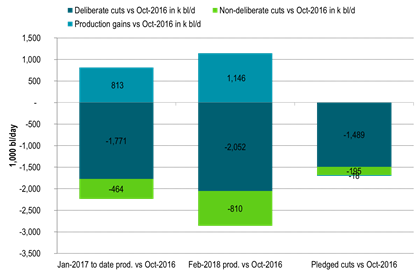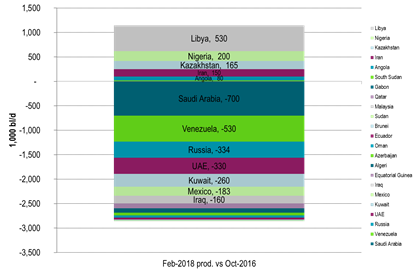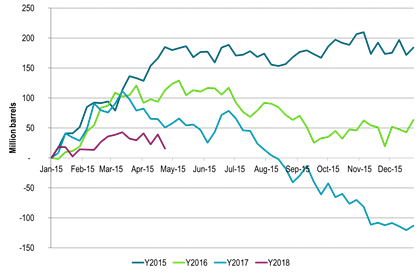Analys
It’s artificial, but is still real and prices will tick higher

 Donald’s tweet on Friday that the OPEC cartel is keeping oil prices artificially high sent Brent crude down to an intraday low of $72.88/bl. The market later in the day totally disregarded the tweet sending Brent to its highest close of the week at $74.06/bl, up $0.4/bl on the day, +2% w/w and the highest close since November 2014. Of course Donald is totally right. The market is artificially tight because the OPEC+ cartel has deliberately cut production. In total its production is down 1.7 m bl/d versus Oct 2016. In our view there were deliberate cuts of 2,052 k bl/d in February if we cut out involuntary cuts of 810 k bl/d and production gains of 1,146 k bl/d. Of course Donald is right that it is the OPEC+ cartel which is driving the market. Tell us something new! That has been the case since their decision in October 2016. Of course the cartel has been lucky since their strategy has been supported by synchronised global growth and very strong oil demand growth as well as production in Venezuela falling like a rock. If it had not been for the very strong global oil demand growth their strategy would probably have been very close to failure since US crude oil production is reviving so strongly. In our estimate they will not be able to exit their cuts in 2019 without driving global inventories back up again. That is why an extension of their agreement to 2019 is on the agenda for the meeting in Vienna on June 20/21/22. So the market is artificially tight but it is the oil market reality of today. They are cutting, oil demand is strong, inventories are going down and prices are moving higher. The OPEC+ cartel will in our view be in control of the market in 2019 unless we have a global recession. They can put some of their cuts back into the market, but not all. Any involuntary production cuts by Venezuela, Libya, Mexico or possibly Iran will of course be welcomed by the deliberate cutters in the group.
Donald’s tweet on Friday that the OPEC cartel is keeping oil prices artificially high sent Brent crude down to an intraday low of $72.88/bl. The market later in the day totally disregarded the tweet sending Brent to its highest close of the week at $74.06/bl, up $0.4/bl on the day, +2% w/w and the highest close since November 2014. Of course Donald is totally right. The market is artificially tight because the OPEC+ cartel has deliberately cut production. In total its production is down 1.7 m bl/d versus Oct 2016. In our view there were deliberate cuts of 2,052 k bl/d in February if we cut out involuntary cuts of 810 k bl/d and production gains of 1,146 k bl/d. Of course Donald is right that it is the OPEC+ cartel which is driving the market. Tell us something new! That has been the case since their decision in October 2016. Of course the cartel has been lucky since their strategy has been supported by synchronised global growth and very strong oil demand growth as well as production in Venezuela falling like a rock. If it had not been for the very strong global oil demand growth their strategy would probably have been very close to failure since US crude oil production is reviving so strongly. In our estimate they will not be able to exit their cuts in 2019 without driving global inventories back up again. That is why an extension of their agreement to 2019 is on the agenda for the meeting in Vienna on June 20/21/22. So the market is artificially tight but it is the oil market reality of today. They are cutting, oil demand is strong, inventories are going down and prices are moving higher. The OPEC+ cartel will in our view be in control of the market in 2019 unless we have a global recession. They can put some of their cuts back into the market, but not all. Any involuntary production cuts by Venezuela, Libya, Mexico or possibly Iran will of course be welcomed by the deliberate cutters in the group.
If it had not been for cuts by the OPEC+ cartel since January 2017 we would probably have had an oil price still somewhere around $50-55/b
Since a 2017 high of 3059.7 in May 2017 the commercial OECD oil inventories have declined 218 million barrels which equals a 0.8 m bl/d daily draw down on average through the period. On average through that period the production of OPEC+ has been 1.4 m bl/d below its October 2016 production level in a mix of deliberate cuts, gains and involuntary cuts. Since the world is bigger than the OECD inventories there has probably been some inventory draws in non-OECD stocks as well. So while the OECD drawdown implied global deficit since May 2017 is 0.8 m bl/d the actual deficit may have been higher, but probably not higher than the net effective cuts of OPEC+ of 1.4 m bl/d over the same period. So yes, our view sides with Donald Trump that if it had not been for cuts by the OPEC+ cartel since January 2017 we would probably have had an oil price still somewhere around $50-55/b or even maybe sub-$50/bl.
There have however hardly been any negative responses to the OPEC+ cartel’s actions up until now on Friday with the tweet by Donald Trump. Not even Donald has acted before now even though production cuts have been going on since the start of 2017. Mostly the action by the cartel has been viewed positively across the board. I cannot remember to have seen any negative takes on it before now. Mostly the take has been that OPEC+ has been doing the world a favour.
OPEC+ has driven the global oil sector out of its investment hysteresis and out of its deep, dark abyss of despair and back into action
Through its cuts, inventory draws and higher prices OPEC+ has driven the global oil sector out of its investment hysteresis and out of its deep, dark abyss of despair and back into action. That is probably a good thing since it will help to reduce the risk for a significant undershoot in supply down the road due to the deep investment cuts in new conventional supply since 2014. And the jury is still out whether we will be able to dodge that bullet when the pipeline of legacy green field conventional oil investments from before 2014 starts to run dry in 2020. Our view is that there is clearly upside price risk due to this on this time horizon.
For the time being we remain bullish for Brent crude oil prices as OPEC+ cuts are intact, their agreement will and must be extended to 2019 at their June 20/21/22 in order to avoid raising inventories in 2019. For the rest of 2018 we expect inventories do draw lower with added supply risk due to Venezuela, Libya and possibly Iran.
If Donald wants to do something he can sign the sanction waivers on May 12 in order to safeguard Iranian crude oil supply. Else his dear voters and consumers are likely to face higher gasoline prices this summer.
Ch1: OPEC+ deliberate cuts, involuntary cuts and gains
Ch2: OPEC+showing who are doing what versus October 2018
C3: Crude and product weekly inventory data versus start of year. Heading lower. Down 23 m bl last week
Analys
A sharp weakening at the core of the oil market: The Dubai curve

Down to the lowest since early May. Brent crude has fallen sharply the latest four days. It closed at USD 64.11/b yesterday which is the lowest since early May. It is staging a 1.3% rebound this morning along with gains in both equities and industrial metals with an added touch of support from a softer USD on top.

What stands out the most to us this week is the collapse in the Dubai one to three months time-spread.
Dubai is medium sour crude. OPEC+ is in general medium sour crude production. Asian refineries are predominantly designed to process medium sour crude. So Dubai is the real measure of the balance between OPEC+ holding back or not versus Asian oil demand for consumption and stock building.
A sharp weakening of the front-end of the Dubai curve. The front-end of the Dubai crude curve has been holding out very solidly throughout this summer while the front-end of the Brent and WTI curves have been steadily softening. But the strength in the Dubai curve in our view was carrying the crude oil market in general. A source of strength in the crude oil market. The core of the strength.
The now finally sharp decline of the front-end of the Dubai crude curve is thus a strong shift. Weakness in the Dubai crude marker is weakness in the core of the oil market. The core which has helped to hold the oil market elevated.
Facts supports the weakening. Add in facts of Iraq lifting production from Kurdistan through Turkey. Saudi Arabia lifting production to 10 mb/d in September (normal production level) and lifting exports as well as domestic demand for oil for power for air con is fading along with summer heat. Add also in counter seasonal rise in US crude and product stocks last week. US oil stocks usually decline by 1.3 mb/week this time of year. Last week they instead rose 6.4 mb/week (+7.2 mb if including SPR). Total US commercial oil stocks are now only 2.1 mb below the 2015-19 seasonal average. US oil stocks normally decline from now to Christmas. If they instead continue to rise, then it will be strongly counter seasonal rise and will create a very strong bearish pressure on oil prices.
Will OPEC+ lift its voluntary quotas by zero, 137 kb/d, 500 kb/d or 1.5 mb/d? On Sunday of course OPEC+ will decide on how much to unwind of the remaining 1.5 mb/d of voluntary quotas for November. Will it be 137 kb/d yet again as for October? Will it be 500 kb/d as was talked about earlier this week? Or will it be a full unwind in one go of 1.5 mb/d? We think most likely now it will be at least 500 kb/d and possibly a full unwind. We discussed this in a not earlier this week: ”500 kb/d of voluntary quotas in October. But a full unwind of 1.5 mb/d”
The strength in the front-end of the Dubai curve held out through summer while Brent and WTI curve structures weakened steadily. That core strength helped to keep flat crude oil prices elevated close to the 70-line. Now also the Dubai curve has given in.

Brent crude oil forward curves

Total US commercial stocks now close to normal. Counter seasonal rise last week. Rest of year?

Total US crude and product stocks on a steady trend higher.

Analys
OPEC+ will likely unwind 500 kb/d of voluntary quotas in October. But a full unwind of 1.5 mb/d in one go could be in the cards

Down to mid-60ies as Iraq lifts production while Saudi may be tired of voluntary cut frugality. The Brent December contract dropped 1.6% yesterday to USD 66.03/b. This morning it is down another 0.3% to USD 65.8/b. The drop in the price came on the back of the combined news that Iraq has resumed 190 kb/d of production in Kurdistan with exports through Turkey while OPEC+ delegates send signals that the group will unwind the remaining 1.65 mb/d (less the 137 kb/d in October) of voluntary cuts at a pace of 500 kb/d per month pace.

Signals of accelerated unwind and Iraqi increase may be connected. Russia, Kazakhstan and Iraq were main offenders versus the voluntary quotas they had agreed to follow. Russia had a production ’debt’ (cumulative overproduction versus quota) of close to 90 mb in March this year while Kazakhstan had a ’debt’ of about 60 mb and the same for Iraq. This apparently made Saudi Arabia angry this spring. Why should Saudi Arabia hold back if the other voluntary cutters were just freeriding? Thus the sudden rapid unwinding of voluntary cuts. That is at least one angle of explanations for the accelerated unwinding.
If the offenders with production debts then refrained from lifting production as the voluntary cuts were rapidly unwinded, then they could ’pay back’ their ’debts’ as they would under-produce versus the new and steadily higher quotas.
Forget about Kazakhstan. Its production was just too far above the quotas with no hope that the country would hold back production due to cross-ownership of oil assets by international oil companies. But Russia and Iraq should be able to do it.
Iraqi cumulative overproduction versus quotas could reach 85-90 mb in October. Iraq has however steadily continued to overproduce by 3-5 mb per month. In July its new and gradually higher quota came close to equal with a cumulative overproduction of only 0.6 mb that month. In August again however its production had an overshoot of 100 kb/d or 3.1 mb for the month. Its cumulative production debt had then risen to close to 80 mb. We don’t know for September yet. But looking at October we now know that its production will likely average close to 4.5 mb/d due to the revival of 190 kb/d of production in Kurdistan. Its quota however will only be 4.24 mb/d. Its overproduction in October will thus likely be around 250 kb/d above its quota with its production debt rising another 7-8 mb to a total of close to 90 mb.
Again, why should Saudi Arabia be frugal while Iraq is freeriding. Better to get rid of the voluntary quotas as quickly as possible and then start all over with clean sheets.
Unwinding the remaining 1.513 mb/d in one go in October? If OPEC+ unwinds the remaining 1.513 mb/d of voluntary cuts in one big go in October, then Iraq’s quota will be around 4.4 mb/d for October versus its likely production of close to 4.5 mb/d for the coming month..
OPEC+ should thus unwind the remaining 1.513 mb/d (1.65 – 0.137 mb/d) in one go for October in order for the quota of Iraq to be able to keep track with Iraq’s actual production increase.
October 5 will show how it plays out. But a quota unwind of at least 500 kb/d for Oct seems likely. An overall increase of at least 500 kb/d in the voluntary quota for October looks likely. But it could be the whole 1.513 mb/d in one go. If the increase in the quota is ’only’ 500 kb/d then Iraqi cumulative production will still rise by 5.7 mb to a total of 85 mb in October.
Iraqi production debt versus quotas will likely rise by 5.7 mb in October if OPEC+ only lifts the overall quota by 500 kb/d in October. Here assuming historical production debt did not rise in September. That Iraq lifts its production by 190 kb/d in October to 4.47 mb/d (August level + 190 kb/d) and that OPEC+ unwinds 500 kb/d of the remining quotas in October when they decide on this on 5 October.

Analys
Modest draws, flat demand, and diesel back in focus

U.S. commercial crude inventories posted a marginal draw last week, falling by 0.6 million barrels to 414.8 million barrels. Inventories remain 4% below the five-year seasonal average, but the draw is far smaller than last week’s massive 9.3-million-barrel decline. Higher crude imports (+803,000 bl d WoW) and steady refinery runs (93% utilization) helped keep the crude balance relatively neutral.

Yet another drawdown indicates commercial crude inventories continue to trend below the 2015–2022 seasonal norm (~440 million barrels), though at 414.8 million barrels, levels are now almost exactly in line with both the 2023 and 2024 trajectory, suggesting stable YoY conditions (see page 3 attached).
Gasoline inventories dropped by 1.1 million barrels and are now 2% below the five-year average. The decline was broad-based, with both finished gasoline and blending components falling, indicating lower output and resilient end-user demand as we enter the shoulder season post-summer (see page 6 attached).
On the diesel side, distillate inventories declined by 1.7 million barrels, snapping a two-week streak of strong builds. At 125 million barrels, diesel inventories are once again 8% below the five-year average and trending near the low end of the historical range.
In total, commercial petroleum inventories (excl. SPR) slipped by 0.5 million barrels on the week to ish 1,281.5 million barrels. While essentially flat, this ends a two-week streak of meaningful builds, reflecting a return to a slightly tighter situation.
On the demand side, the DOE’s ‘products supplied’ metric (see page 6 attached), a proxy for implied consumption, softened slightly. Total demand for crude oil over the past four weeks averaged 20.5 million barrels per day, up just 0.9% YoY.
Summing up: This week’s report shows a re-tightening in diesel supply and modest draws across the board, while demand growth is beginning to flatten. Inventories remain structurally low, but the tone is less bullish than in recent weeks.


-

 Nyheter3 veckor sedan
Nyheter3 veckor sedanMahvie Minerals i en guldtrend
-

 Nyheter4 veckor sedan
Nyheter4 veckor sedanEurobattery Minerals satsar på kritiska metaller för Europas självförsörjning
-

 Nyheter4 veckor sedan
Nyheter4 veckor sedanGuldpriset kan närma sig 5000 USD om centralbankens oberoende skadas
-

 Nyheter4 veckor sedan
Nyheter4 veckor sedanOPEC signalerar att de inte bryr sig om oljepriset faller kommande månader
-

 Analys3 veckor sedan
Analys3 veckor sedanVolatile but going nowhere. Brent crude circles USD 66 as market weighs surplus vs risk
-

 Nyheter3 veckor sedan
Nyheter3 veckor sedanAktier i guldbolag laggar priset på guld
-

 Nyheter3 veckor sedan
Nyheter3 veckor sedanKinas elproduktion slog nytt rekord i augusti, vilket även kolkraft gjorde
-

 Nyheter2 veckor sedan
Nyheter2 veckor sedanTyskland har så höga elpriser att företag inte har råd att använda elektricitet










